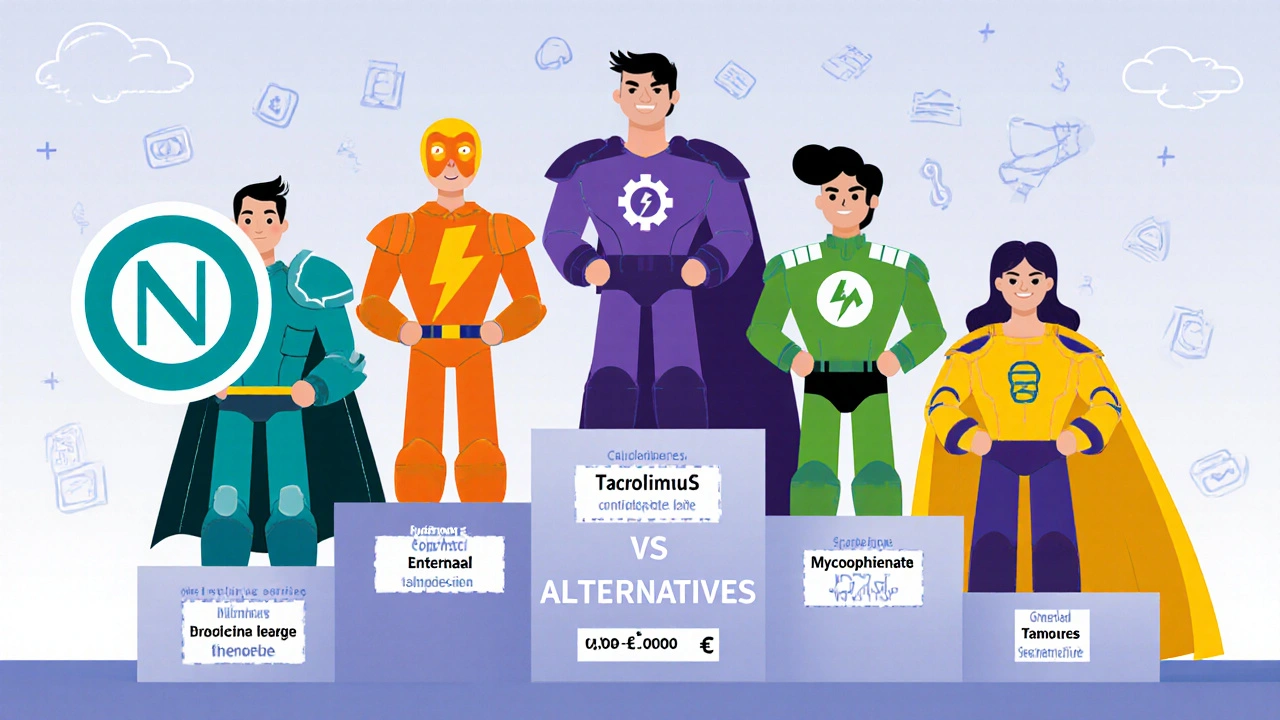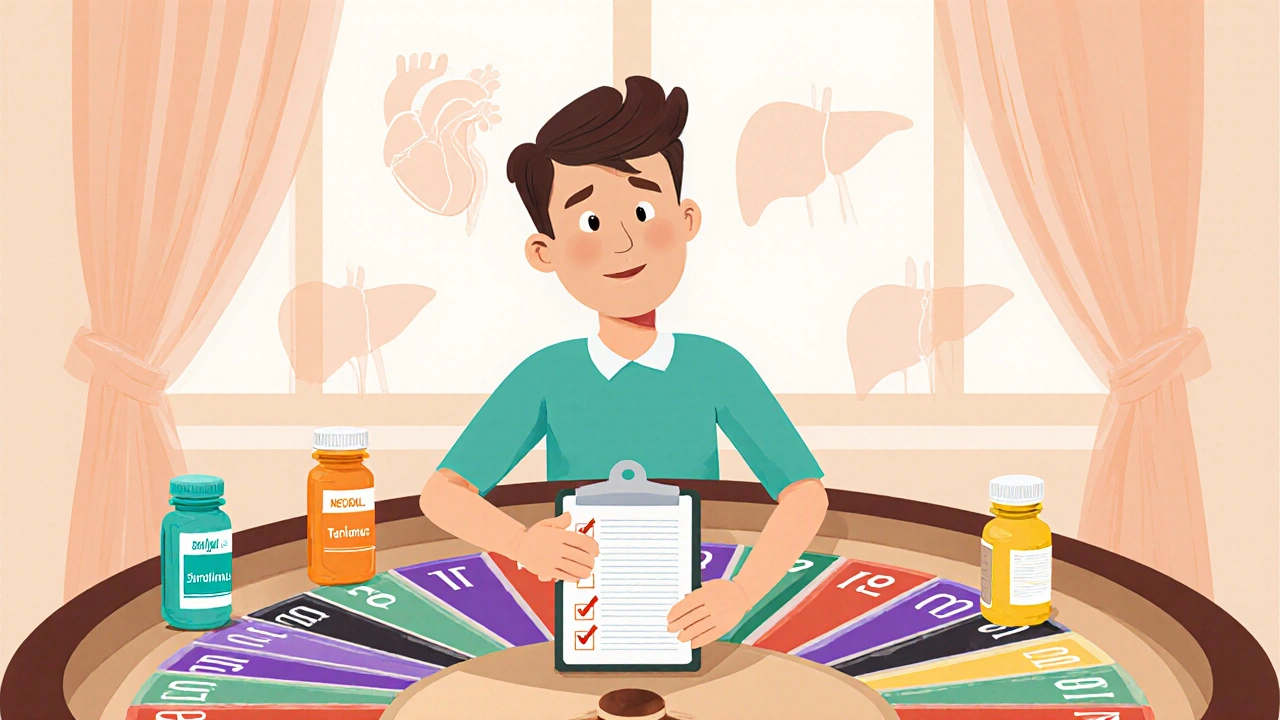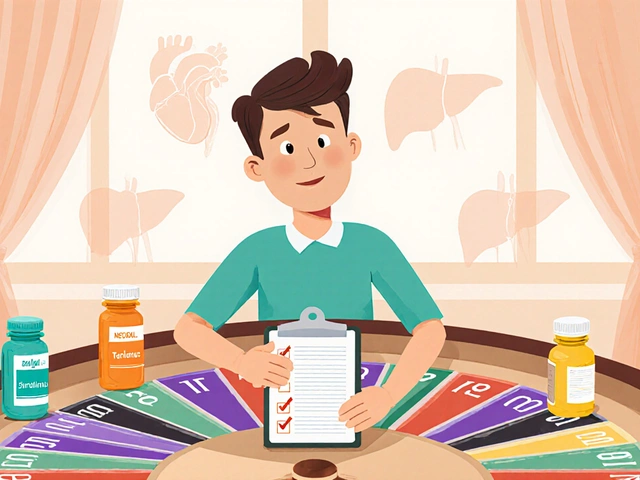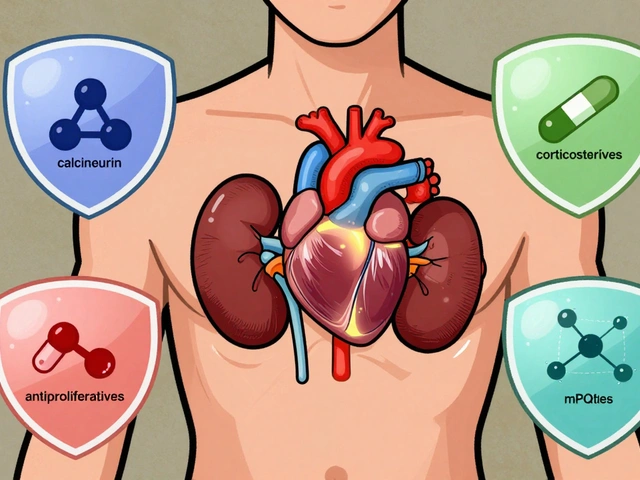Immunosuppressant Cost Calculator
Cost Comparison Tool
Estimate monthly costs for immunosuppressant drugs based on UK pricing data (2025). Note: Actual costs vary based on dose, insurance, and individual patient factors.
Enter your dose to see estimated monthly cost
Important Notes: Actual costs depend on your specific treatment plan, insurance coverage, and pharmacy pricing. These estimates are for educational purposes only. Always consult your transplant team for personalized advice.
When a patient receives an organ transplant, the choice of immunosuppressant can feel like a high‑stakes gamble. You want the medicine that keeps rejection at bay without wrecking your health or wallet. This guide puts Neoral side‑by‑side with the most common alternatives, so you can see the real trade‑offs and ask the right questions at the pharmacy or clinic.
What is Neoral (Cyclosporine)?
Neoral (Cyclosporine) is a calcineurin inhibitor that suppresses the immune system by blocking the activation of T‑cells. First approved in the early 1980s, it quickly became a staple for kidney, liver, and heart transplant recipients. The drug is taken orally, usually twice a day, and requires regular blood‑level monitoring because the therapeutic window is narrow - too low and the organ may be rejected; too high and you risk kidney damage or high blood pressure.
Neoral is marketed as a microemulsion formulation, which improves absorption compared with the older Sandimmune version. This makes dosing a bit more predictable, but it also means the medicine can interact with a wide range of other drugs, especially those that use the CYP3A4 pathway.
Common Alternatives to Neoral
Over the past two decades, several other immunosuppressants have entered the market, each with its own mechanism and side‑effect profile. Below are the five most frequently prescribed alternatives.
- Tacrolimus (brand names Prograf, Advagraf) is another calcineurin inhibitor, but many clinicians find it slightly more potent and easier to manage at lower blood concentrations.
- Sirolimus (brand name Rapamune) works by inhibiting the mTOR pathway, which blocks T‑cell proliferation rather than activation. It’s often paired with a calcineurin inhibitor for a “double‑tactic” approach.
- Mycophenolate mofetil (brand name CellCept) suppresses B‑ and T‑cell proliferation by interfering with nucleotide synthesis. It’s usually given alongside a calcineurin inhibitor or mTOR blocker.
- Azathioprine is an older antimetabolite that reduces DNA synthesis in rapidly dividing cells, including immune cells. It’s less aggressive but also has fewer drug‑interaction concerns.
- Prednisone is a corticosteroid that provides broad immunosuppression and anti‑inflammatory effects. While not a direct alternative, it’s typically part of any post‑transplant regimen and can be tapered off over time.

Side‑by‑Side Comparison
| Drug | Mechanism | Typical Adult Dose | Main Side Effects | Approx. Monthly Cost (GBP) |
|---|---|---|---|---|
| Neoral (Cyclosporine) | Calcineurin inhibition | 3-5 mg/kg/day divided BID | Nephrotoxicity, hypertension, hirsutism, gum hyperplasia | £120‑£180 |
| Tacrolimus | Calcineurin inhibition (more potent) | 0.1-0.2 mg/kg/day divided BID | Neurotoxicity, diabetes, tremor, kidney injury | £150‑£210 |
| Sirolimus | mTOR inhibition | 2 mg once daily (or 0.5 mg weekly loading) | Hyperlipidaemia, delayed wound healing, mouth ulcers | £200‑£260 |
| Mycophenolate mofetil | Inhibits inosine monophosphate dehydrogenase | 1-1.5 g twice daily | GI upset, leukopenia, infections | £80‑£130 |
| Azathioprine | Purine analog - blocks DNA synthesis | 1-2 mg/kg/day once daily | Bone marrow suppression, liver toxicity | £30‑£50 |
How to Choose the Right Immunosuppressant
Choosing a drug isn’t just a checklist; it’s a conversation with your transplant team. Here are the most common decision points.
- Organ type and rejection risk - Kidney transplants often start with a calcineurin inhibitor plus mycophenolate. Heart and liver patients may need a stronger calcineurin blocker (Tacrolimus) or an mTOR agent (Sirolimus) for better long‑term outcomes.
- Pre‑existing conditions - If you have diabetes, Tacrolimus could worsen blood sugar; Sirolimus may raise cholesterol. Patients with hypertension might struggle with Neoral’s blood‑pressure‑raising effect.
- Side‑effect tolerance - Some people can’t handle the gum overgrowth that comes with Neoral. Others find the tremor from Tacrolimus intolerable and prefer Mycophenolate’s milder profile.
- Drug‑interaction landscape - If you’re already on antifungal or certain antibiotics, Neolar’s CYP3A4 metabolism can cause big swings in blood levels. Azathioprine and Mycophenolate have fewer such interactions.
- Cost and insurance coverage - The UK’s NHS typically favours generics like Mycophenolate and Azathioprine, but some transplant centres provide subsidies for newer agents. Check your local formulary.
Ultimately, the optimal regimen often combines two or three agents at lower doses, balancing efficacy with tolerability.

Practical Considerations: Monitoring, Interactions & Lifestyle
Regardless of the drug you land on, there are universal habits that keep you safe.
- Blood level checks - Both Neoral and Tacrolimus require trough level measurements every 1-2 weeks after starting, then monthly once stable. Sirolimus and Mycophenolate need less frequent labs but still require complete blood counts.
- Kidney function - Since calcineurin inhibitors can be nephrotoxic, your nephrologist will track creatinine and eGFR closely. A sudden rise may trigger a dose reduction.
- Diet - High‑fat meals can boost absorption of cyclosporine, while grapefruit juice can dramatically raise levels of many of these agents. Stick to a consistent diet and avoid grapefruit.
- Vaccinations - Live vaccines are off‑limits while on strong immunosuppression. Inactivated flu and COVID‑19 shots are encouraged, but schedule them when your drug levels are at the lower end of the therapeutic range.
- Pregnancy - Neoral is classified as Category C; Tacrolimus is Category C as well, but both cross the placenta. Mycophenolate is contraindicated in pregnancy. If you plan a family, discuss a switch with your team early.
Frequently Asked Questions
Can I switch from Neoral to Tacrolimus after a transplant?
Yes, many centres transition patients from Neoral to Tacrolimus if they develop nephrotoxicity or hypertension. The switch is done gradually with overlapping blood‑level monitoring to avoid rejection.
Why does Neoral cause hirsutism and gum overgrowth?
Cyclosporine stimulates fibroblast activity and alters hormone metabolism, leading to excess hair growth and gingival hyperplasia in up to 30% of patients. Good oral hygiene and regular dental visits can mitigate gum issues.
Is Mycophenolate safe for patients with liver disease?
Mycophenolate is generally well‑tolerated in liver transplant recipients because it does not affect renal function directly. However, monitor liver enzymes regularly, especially during the first three months.
How does Sirolimus affect wound healing?
Sirolimus blocks the mTOR pathway, which is crucial for cell proliferation during tissue repair. Patients often experience slower incision healing, so surgeons may postpone Sirolimus initiation until the wound is fully closed.
What monitoring is required for Azathioprine?
Complete blood count and liver function tests every 2-4 weeks for the first three months, then every 3 months once stable. Dose adjustments are made based on leukocyte counts.
By laying out the mechanisms, side effects, costs, and monitoring needs, you can have an informed chat with your transplant team. Whether you stick with Neoral or move to another agent, the goal is the same: keep the new organ thriving while you stay as healthy as possible.




Jana Winter
October 16, 2025 AT 15:52The phrase “high‑stakes gamble” in the opening paragraph is a classic case of mixed metaphors; it should be “high‑stakes risk” if you want precision. Also, “microemulsion” needs a hyphen for correct orthography. The article occasionally slips into passive voice, e.g., “can be felt,” which weakens the impact. While the content is solid, tighter language would boost credibility. Remember, readers notice even tiny grammar slips, especially in medical writing.
Linda Lavender
October 25, 2025 AT 21:52When it comes to the labyrinthine world of post‑transplant pharmacology, few topics inspire as much melodramatic fervor as the great showdown between Neoral and its worthy rivals.
The very notion that a single molecule can dictate the fate of a newly minted organ is both terrifying and awe‑inspiring, evoking the kind of existential dread that would make a Shakespearean tragedy blush.
Yet, beneath the theatrical veneer lies a cold, hard calculus of blood levels, enzyme pathways, and, yes, the ever‑present specter of cost.
One must first acknowledge that cyclosporine, despite its vintage pedigree, still clings to the market like an indolent aristocrat refusing to relinquish his throne.
Its micro‑emulsion formulation, while a marvel of pharmaceutical engineering, also opens the door to a veritable carnival of drug–drug interactions that can send trough levels soaring or crashing without warning.
Tacrolimus, the younger sibling in the calcineurin family, offers a slightly sharper edge, yet it brings its own brand of neurotoxicity that can render a patient trembling like a leaf in a gale.
Sirolimus, perched atop the mTOR pathway, promises a gentler immunosuppressive profile but extracts a heavy toll in hyperlipidaemia, rendering patients lipid‑laden in a way that would make any cardiologist sigh.
Mycophenolate, perhaps the most ubiquitous adjunct, sidesteps the nephrotoxic pitfalls but introduces a gastrointestinal maelstrom that can leave patients clutching the bathroom door in despair.
Azathioprine, the humble antimetabolite, may appear as the modest underdog, yet its bone‑marrow suppression potential is no trivial matter and demands vigilant monitoring.
Prednisone, the ever‑present corticosteroid, is the wildcard that can mask or exacerbate the side‑effects of its companions, a true chameleon in the therapeutic tableau.
When we examine the financial tableau, the stark disparity between a £30‑£50 azathioprine regimen and a £200‑plus Sirolimus plan becomes a decisive factor for many healthcare systems, especially those operating under austerity.
Moreover, the psychosocial burden of hirsutism or gum hypertrophy, hallmarks of cyclosporine, can erode a patient’s self‑esteem with a relentless, almost poetic cruelty.
Thus, the decision matrix is not merely a checklist of lab values but a symphony of clinical nuance, patient preference, and socioeconomic reality.
A multidisciplinary team, armed with therapeutic drug monitoring and a keen eye for comorbidities, must choreograph a regimen that balances potency with tolerability.
In the final analysis, the true victor is the one who preserves organ function while allowing the patient to live, love, and occasionally laugh without the constant shadow of side‑effects looming large.
Jay Ram
November 4, 2025 AT 03:52Honestly, scrolling through the drug comparison feels like getting a cheat sheet for the transplant clinic; you can actually see which med might suit your lifestyle. Keep an eye on those blood‑level checks, and don’t forget to schedule your labs like a regular appointment.
Elizabeth Nicole
November 13, 2025 AT 09:52I totally get the drama you described; it’s wild how a single pill can dominate a whole post‑transplant plan. Still, it’s reassuring that the field offers so many alternatives, giving patients a real chance to find a tolerable balance.
Dany Devos
November 22, 2025 AT 15:52From a pharmacoeconomic perspective, the cost variance between azathioprine and sirolimus is striking; healthcare budgets must weigh efficacy against expenditure, especially when the NHS favors generics. Policymakers should consider long‑term outcomes, not just monthly pricing.
Sam Matache
December 1, 2025 AT 21:52Neoral is basically the granddad of transplant meds.